ASM Metals HandBook Vol. 8 - Mechanical Testing and Evaluation
Подождите немного. Документ загружается.

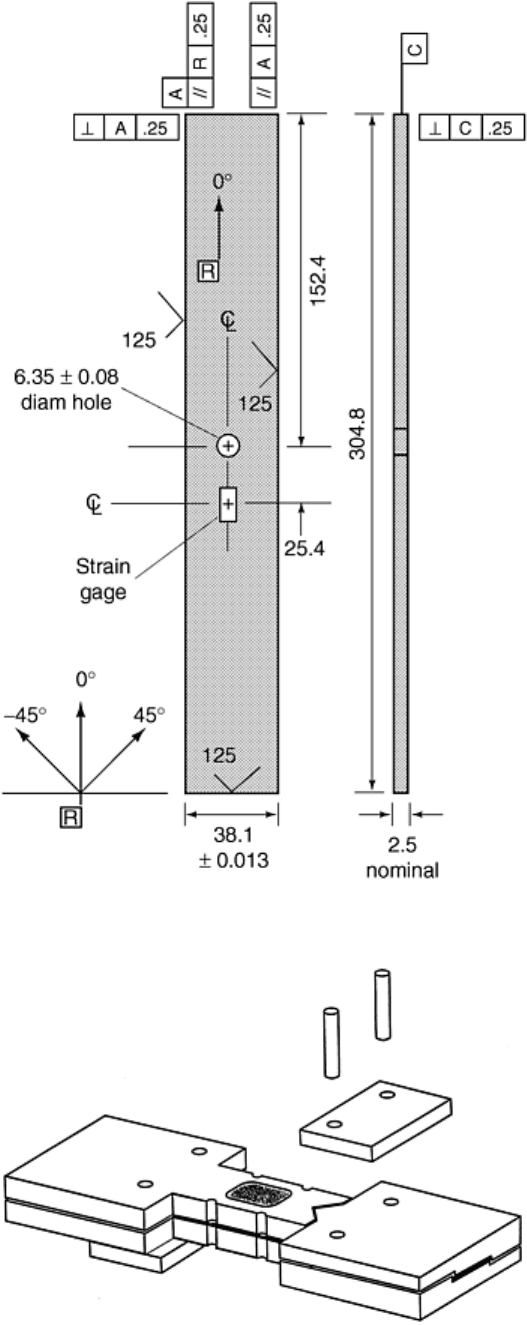
Fig. 27 Open hole compression test specimen geometry. All dimensions are in millimeters.
Fig. 28 Test fixture for the SACMA SRM-3 open hole compression test
Loading can be accomplished through two methods. The fixture halves can be bolted together, and the
specimen is end loaded between compression platens after verifying that the specimen and fixture are
perpendicular to the platens. The other method uses hydraulic grips that can simultaneously grip the fixture to
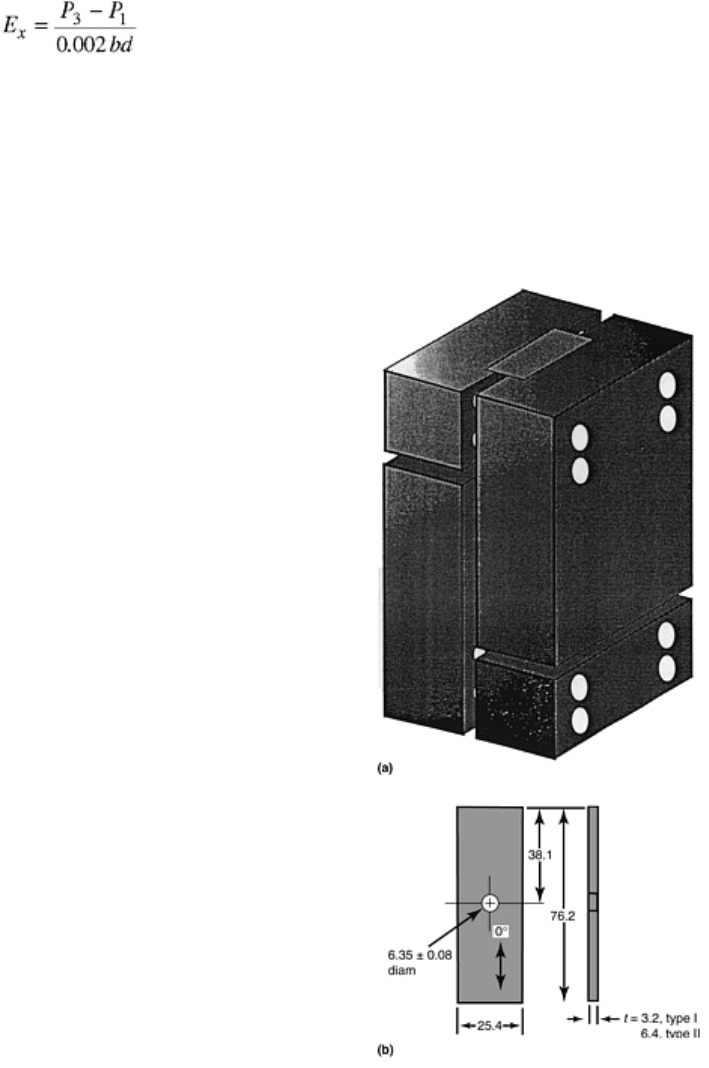
hold the specimen and apply compression through shear developed by friction between the fixture and
specimen. This method is preferred but is often not available. The specimen is tested until failure and the
following data reduction analysis applied to determine the open hole compression strength:
σ
ult
= P/bd
(Eq 23)
where P is the maximum load, b is the specimen width, and d is the specimen thickness.
Gripping pressure, a controllable test parameter with hydraulic grips, can influence the strengths measured if
carried to an extreme. High clamping pressures induce transverse normal constraint that may raise the
compression failure load. Since such transverse normal constraints are not present in most structural
applications, the use of high clamping forces to increase open hole compression strength is nonconservative and
ill-advised.
If strain is measured, the elastic modulus can be determined using the following equation:
(Eq 24)
where b and d are the specimen dimensions and P
3
and P
1
are the loads at 3000 and 1000 microstrain. The
ultimate open hole compression strain is found from the stress-strain plot.
Another test method is based on the “Northrop specimen and fixture” (Fig. 29), which uses a smaller test
specimen than that shown in Fig. 27. It is also end-loaded and face-supported, but due to different geometry and
boundary constraints it gives different strength than the SACMA method. There is no technical basis at this
time to recommend one method over the other, but the Northrop specimen and fixture are less expensive and
the method is easier to use than the SACMA method. Because of its lower mass, it is easier to use for testing
under variable temperature and moisture conditions.
Fig. 29 Northrop test fixture and specimen geometry for the open hole compression test
Compression-after-Impact (CAI) Test
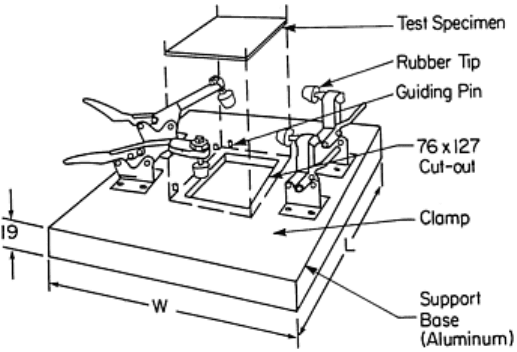
Concerns about damage tolerance of composites in primary load bearing aircraft structures prompted the
development of test methods to measure fracture toughness and damage tolerance. Fracture mechanics test
methods have been adapted to measure interlaminar crack growth resistance and are covered in the next section
of this article, “Interlaminar Fracture.” Damage tolerance tests have been developed that simulate foreign object
impact and then measure residual strength properties of the “damaged” laminates.
The tests are quite complex since they involve two separate and distinct events, damage generation by impact
and compression strength testing of impacted specimens that involves post-impact damage propagation.
Damage is imparted by striking a test laminate with a projectile or instrumented impact tup having a specified
energy. During impact, the test panel, usually a quasi-isotropic laminate, is held by a fixture capable of
consistently applying defined boundary conditions. During impact the specimen can be loaded or unloaded.
Depending on the geometry of the impactor, the energy applied, and the toughness and lay-up of the test panel,
damage can range from through-penetration to nonvisible internal delamination. It is important to have a
nondestructive method to assess the level of damage sustained by the specimen before testing for residual
strength. While either tension or compression loading can be applied to determine residual strength,
compression is most common. Under tension loading, the strength tends to be reduced by an amount equivalent
to the laminate having a hole similar in size to the primary damage zone. In compression, sublaminate buckling
occurs as a result of the delaminations in the damage zone, amplifying the reduction in strength.
A method popularized by Boeing in specification BSS 7260 became, by virtue of widespread use, a defacto
industry standard for materials screening. The method was formalized by publication of SACMA SRM-2 and is
currently under development as an ASTM standard test method. This method covers both the impact and
compression after impact testing of a composite laminate. The impact is produced by a falling weight with a
15.9 mm (0.625 in.) diameter hemisperical tup dropped from a height so as to produce 170 Nm (1500 lbf · in.)
of energy per 25.4 mm (1 in.) of laminate thickness. The test panel is nominally 152 by 102 mm (6 by 4 in.)
wide by 5 mm (0.2 in.) thick and is held during impact by mechanical clamps on a steel fixture with a 76 by
127 mm (3 in. by 5 in.) opening (Fig. 30). Subsequent to impact, the laminate is ultrasonically scanned to reveal
the extent of damage imparted and then subjected to compression testing. The panel is not loaded during impact
and is used to assess damage tolerance due to low-velocity, nonpenetrating impact.
Fig. 30 Fixture used to support the test specimen during impact for the compression-after-impact (CAI)
test. Dimensions are in millimeters.
A quasi-isotropic [45/0/-45/90°]
3s
laminate machined to the specifications summarized in Fig. 31 is used as a
test specimen. The number of repeating units should be adjusted for different grades of prepreg in order to keep
the laminate in the 4 to 6 mm (0.16 to 0.24 in.) cured thickness range. It is highly recommended that the test
panel be instrumented with four strain gages located as indicated in Fig. 31 to characterize any eccentricity in
loading and to indicate the onset of any excessive delamination growth in the test specimen under compression
loading.
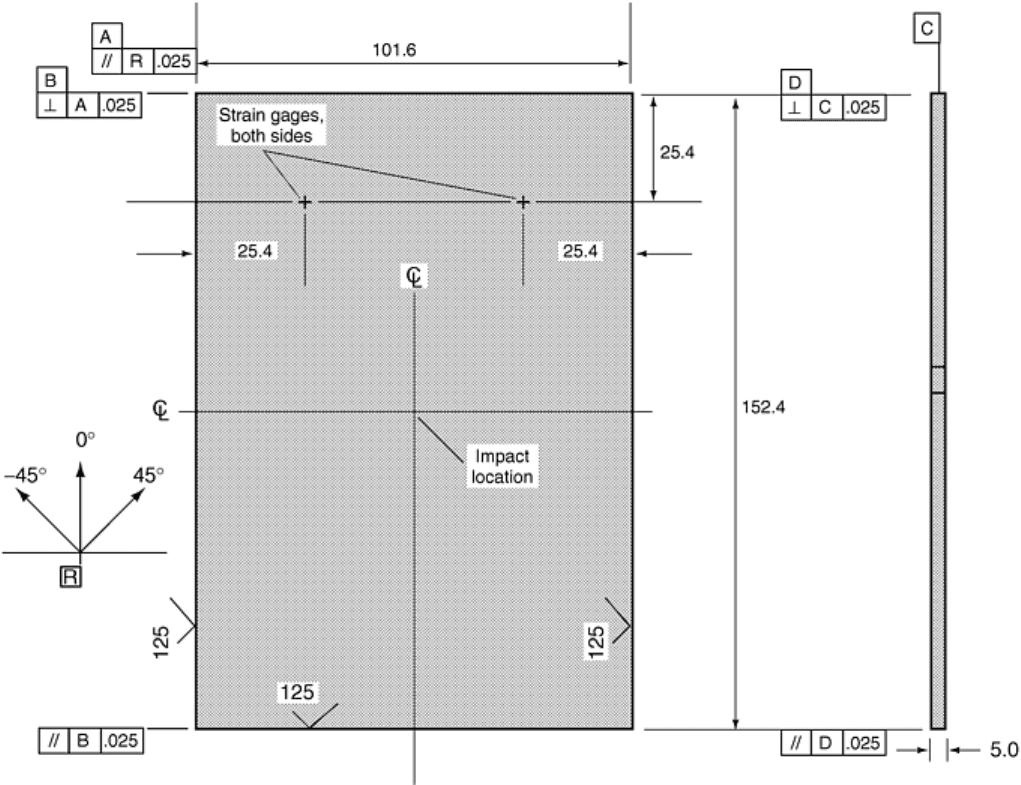
Fig. 31 Specimen geometry for the compression-after-impact test
The compression test is carried out using the fixture shown in Fig. 32. The vertical edges of the specimen are
lightly supported by knife edges to simulate simply supported conditions, and the specimen is clamped along
the top and bottom edges. The clamping along the top and bottom help constrain brooming failures at the load
introduction boundaries. The test is carried out at a loading rate of 1.5 mm/min (0.05 in./min) in a load frame of
at least 250 kN capacity until failure occurs as indicated by a drop in the load deflection curve.

Fig. 32 The test fixture used to conduct compression-after-impact testing
Typical stress-strain results are shown in Fig. 33. Ideally, the four strain gages will track closely with each
other. Separation is an indication of eccentricity in load introduction. Divergence near the failure load indicates
the onset of global buckling, and early divergence is an indication of sublaminate delamination growth and
buckling instability. The compression after impact strength, σ
ult
, is calculated by dividing the failure load by the
cross-sectional area:
σ
ult
= P
ult
/bd
(Eq 25)
where P
ult
is the failure load, and b and d are the specimen width and thickness respectively. The test results are
not considered valid if the impact damage area extends to the edge of the test plaque; these specimens are
normally removed from the test matrix. Indication of excessive eccentricity during loading, normally caused by
improper specimen machining, and failure of the specimen at a location outside the impact damage zone are
reasons to invalidate test results. It is important to examine and record failure location and mode as part of the
test results.
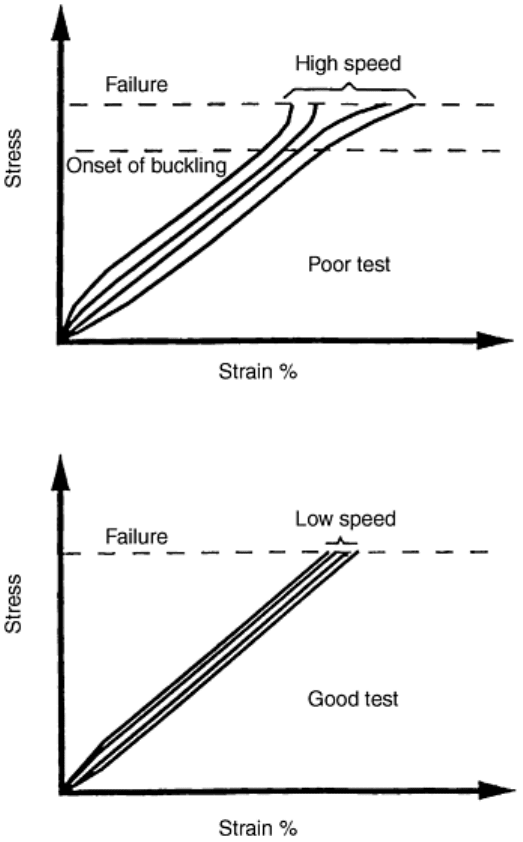
Fig. 33 Typical stress-strain behavior in a compression-after-impact test
A number of factors pertaining to the impact and compression test can influence the test results. A single
impact is specified, and rebound impacts must be prevented. The weight of the tup assembly and the velocity of
the impact can influence the type and amount of damage generated. The stiffness of the base assembly holding
the specimen during impact affects the energy transfer, and, hence, the damage imparted to the specimen. A
study by Fallabella et al. (Ref 49) showed this effect by comparing the plywood base originally employed by
Boeing and the steel base specified by SACMA. Specimens impacted on the steel base incurred greater damage
and exhibited lower compression-after-impact (CAI) strengths.
The compression test is sensitive to the amount of clamping pressure used to constrain the specimen during
testing. The test specifies light constraint. Heavy clamping pressures can produce higher failure loads by
changing the boundary conditions along the edges of the plate. Alignment is critical to prevent premature
failures due to bending induced by loading eccentricity. Both the fixture and the specimen can be sources of
misalignment and eccentric load introduction. Most fixtures have alignment features, so lack of specimen
conformance to machining tolerances is the most common source of variability in load introduction.
Compression-after-impact test results from the SACMA method allow comparison of material performances
under the specific conditions imparted by this test. The CAI data alone do not completely characterize a
materials damage tolerance or toughness properties. CAI strength must be combined with other fracture
toughness and mechanical property results to draw significant conclusions about the capabilities of a material.
Design allowables should not be based on CAI test results. Subscale component tests must be used to provide
the type of data required to assess a material's performance under design conditions.
Footnote

*
The section “Interlaminar Shear Properties of Fiber-Reinforced Composites at High Strain
Rates” was written
by John Harding and Stephen Hallett, Oxford University. The section “Fatigue Testing and Behavior of Fiber-
Reinforced Composites” was written by W. Steven Johnson and Ramesh Talreja, Georgia Institute of
Technology.
References cited in this section
8. L.A. Carlsson and R.B. Pipes, Experimental Characterization of Advanced Composite Materials, 2nd
ed., Technomic, Lancaster, 1987
45. J.M. Ogonowski, Analytical Study of Finite Geometry Plates with Stress Concentrations, AIAA Paper
80-0778, American Institute of Aeronautics and Astronautics, New York, 1980, p 694
46. J.M. Whitney and R.J. Nuismer, Stress Fracture Criteria for Laminated Composites Containing Stress
Concentrations, J. Compos. Mater., Vol 8, 1974, p 253
47. R.B. Pipes, R.C. Wetherhold, and J.W. Gillespie, Jr., Notched Strength of Composite Materials, J.
Compos. Mater., Vol 13, 1979, p 148
48. E.G. Gynn, W.L. Bradley, and W. Elber, Micromechanics of Compression Failures in Open Hole
Composite Laminates, ASTM STP 1012, 1989, p 118
49. R. Falabella, K.A. Olesen, and M.A. Boyle, Variations in Impact Test Methods for Tough Composites,
Proc. of the 35th International SAMPE Symposium, 2–5 April 1990, p 1454
Mechanical Testing of Fiber-Reinforced Composites
Dale Wilson, The Johns Hopkins University, Leif A. Carlsson, Florida Atlantic University
Interlaminar Fracture
With the introduction of composite materials into primary structures, defect and damage tolerance have become
important issues for design and materials selection. While damage tolerance testing such as compression after
impact testing is performed on substructure specimens or on prototype parts, the use of fracture tests has
become popular for materials screening and qualification programs. Of particular interest is the characterization
of interlaminar fracture resistance of laminated composites.
The short beam shear test is one of the methods most commonly applied to determine interlaminar properties,
but it has many deficiencies. The fracture mechanics approach to interlaminar fracture characterization has
evolved as a more fruitful approach. Fracture mechanics of composites is commonly based on the strain energy
release rate, and fracture toughness is expressed as the work of fracture. Some background will be given in
support of the description of the fracture tests.
It is generally recognized that the resistance to delamination is minimum at the interface between two
unidirectional plies of the same fiber orientation. In composites with angle plies, the delamination may be
deflected away from the desired midplane through matrix cracks, which invalidates the test. In composites with
a tough matrix interleaf film at the midplane, the crack may deflect into an adjacent composite ply due to less
crack growth resistance within the ply than between the plies, which would complicate the interpretation of the
test results. Woven fabric composites possess resin pockets at the crack plane and may show significant
variation in fracture toughness as the delamination grows. Composites with significant interlaminar strength
and toughness, such as metal matrix composites and three-dimensional reinforced composites, may not fail in
the desired delamination mode. Interlaminar testing of such composites would require specialized fixtures and
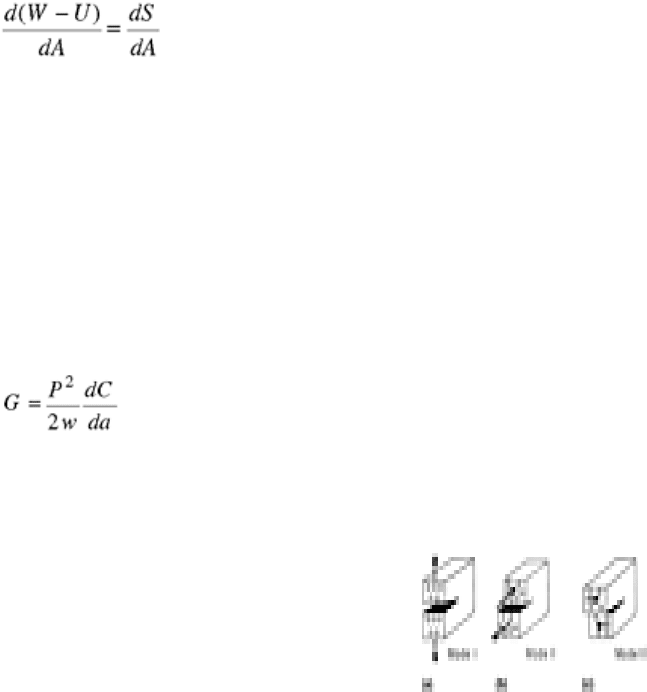
specimens. Consequently, the interlaminar fracture test procedures described here are strictly limited to
unidirectional single-resin matrix composites.
Strain Energy Release Rate
The most commonly employed approach to characterize interlaminar fracture resistance of composites is by the
strain energy release rate. The energy release rate, G, is a thermodynamic parameter that quantifies the energy
available for crack growth. The fracture criterion based on G simply states that fracture (crack growth) will
occur if the energy available for crack growth exceeds the work required to create a unit of new crack area (Ref
50). The energy approach does not require a detailed analysis of the stress state at the crack tip, where a stress
singularity exists. Several delamination fracture tests employ beam specimens, and analysis of the energy
release rate is based on simplified beam theory and strength of materials approaches for the calculation of the
energy release rate of the fracture specimen.
For a specimen of width w containing a crack of length a, the condition for crack growth is:
(Eq 26)
where W is the work performed by external forces, U is the elastic strain energy stored in the body, and S is the
energy for crack formation (Ref 50). dA is the increment of new crack area, and dA = wda. The quantity d(W -
U)/dA is the net driving force for crack extension and is denoted by G. dS/dA is the crack growth resistance. If
the crack growth resistance is independent of crack length, dS/dA is a material constant denoted by G
c
, and is
called “fracture toughness.”
The energy release rate can be related to the rate of change in specimen compliance with change in crack length
(Ref 50). The specimen compliance, C, is defined as:
C = δ/P
(Eq 27)
where δ is the relative displacement of the points of load application, and P is the magnitude of applied load. It
may be shown (Ref 50) that the strain energy release rate is:
(Eq 28)
Crack extension can occur through three distinct fracture modes, as shown in Fig. 34. Mode I is the crack
opening mode, mode II is a shearing mode, and mode III is a tearing mode. Fracture may occur as a result of
any one or a combination of these modes. In this article, only mode I and mode II and mixed mode (I and II)
fracture test methods are covered, although Mode III test methods are being examined (Ref 51, 52).
Fig. 34 Modes of crack surface displacements. (a) Mode I (opening). (b) Mode II (forward shear). (c)
Mode III (antiplane shear)
Several delamination fracture tests have been proposed (Ref 51, 52, 53, 54). This article restricts attention to
only one test of each type. The double cantilever beam (DCB) and end-notched-flex (ENF) test and the mixed-
mode bending (MMB) test methods have been recognized by ASTM Committee D-30 as promising
interlaminar fracture tests.
Mode I Fracture
The DCB specimen for mode I fracture is now an ASTM standard (ASTM D 5528). The purpose of the test is
to determine the opening mode I (Fig. 34a) interlaminar fracture toughness, G
IC
, of continuous fiber composite
materials with a polymer matrix. First developed in a tapered form by Bascom (Ref 55), the specimen has
evolved to a straight-sided geometry, as shown in Fig. 35. The analysis developed for data reduction in the
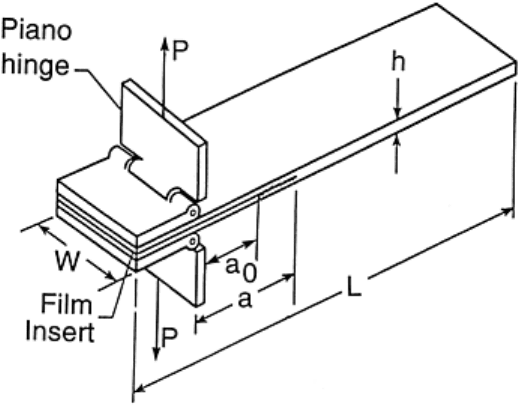
subsequent sections applies only to the straight-sided specimen. The DCB specimen contains a nonadhesive
film insert at the midplane to define a precrack of length a
0
, as shown in Fig. 35. Load is applied to the DCB
specimen via the adhesively bonded hinges until the crack begins to propagate. Load, displacement, and crack
length are monitored during the fracture test.
Fig. 35 Double cantilever beam (DCB) specimen geometry
DCB Specimen Preparation and Testing. The DCB specimen should be at least 125 mm (5 in.) long and
between 20 and 25 mm (0.8 and 1.0 in.) wide. Panels should be manufactured with a nonadhesive Teflon or
Kapton film at the laminate midplane. The film thickness should be less than 13 μm, and the film may be
sprayed with a mold release agent before it is inserted between the plies. The insert length should extend
approximately 63 mm (2.5 in.) from the front edge of the specimen to achieve an approximately 50 mm (2 in.)
long precrack (a
0
~ 50 mm), (Fig. 35). Because it is difficult to detect a thin insert film from the edge of a cut
specimen, it is recommended that the end of the insert be carefully marked on the panel before cutting the
specimens.
The laminate should contain an even number of plies, and the thickness, h, should be between 3 and 5 mm.
Variations in thickness should not exceed 0.1 mm. For thin specimens of large fracture resistance, large
deflections may lead to nonlinear response, and thicker specimens may be selected. After appropriate surface
preparation of the hinges and the composite (see Ref 8), the hinges should be carefully aligned with the
specimen axis and loading line and bonded with a room temperature curing adhesive, such as the adhesives
recommended for the end tabs or cyanoacrylate (superglue).
Thickness and width of the specimen are measured at three points along the specimen length, close to the ends
and at the center, and the results are averaged. The specimen edges are painted with a thin, white coating or
typewriter correction fluid to enhance visualization of crack growth. To aid in recording of crack length, the
first 5 mm (0.2 in.) from the insert are marked with thin vertical lines 1 mm (0.04 in.) apart. The remaining 20
mm (0.8 in.) of test length is marked every 5 mm (0.2 in.). Crack length, a, is the distance from the line of load
application to the crack tip (see Fig. 35).
The DCB specimen is mounted in the grips of a properly calibrated test machine with a sensitive load cell (5
kN, or 1125 lbf, maximum load capacity). The delamination front is observed as the specimen is being loaded.
Load is applied at a crosshead rate of 0.5 mm/min (0.02 in./min), and load versus crosshead displacement is
recorded on an x-y recorder for real time visual inspection of the load-displacement response. Displacement of
the loaded ends, δ in Fig. 36, is estimated from the crosshead travel, provided that the machine and load cell are
stiff enough not to deform more than 2% of the total opening displacement.
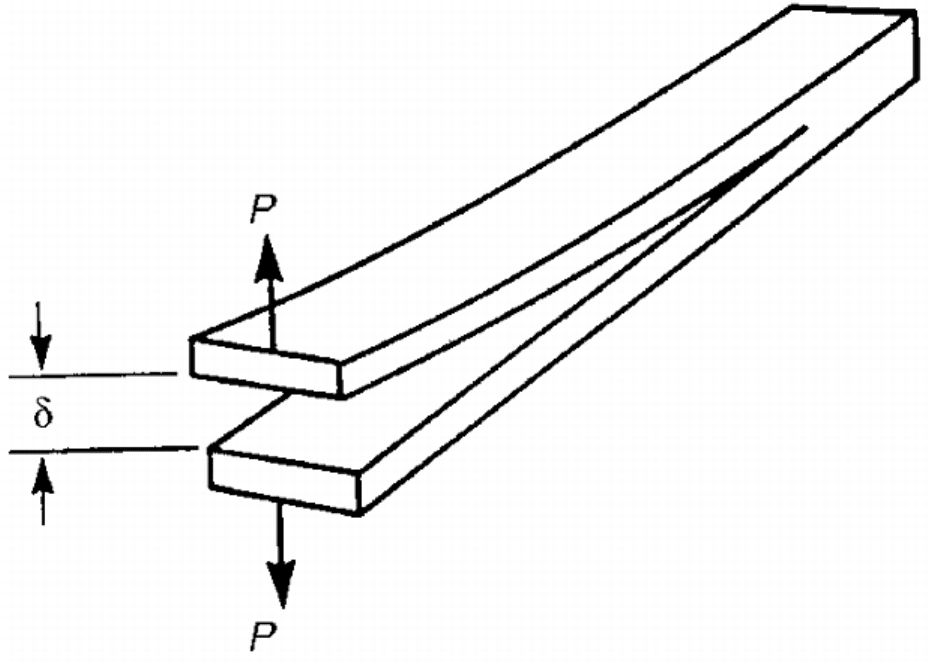
Fig. 36 Definition of crack opening displacement for a double cantilever beam test
The crack front may not grow uniformly across the width of the specimen, so growth must be monitored on
both edges of the specimen. A traveling optical microscope located on one side of the specimen with
approximately 10× magnification and a crosshair can be used to monitor the crack tip location during the
fracture test. A mirror is employed to observe the delamination front on the edge of the specimen away from the
scope. The accuracy of crack length measurement should exceed ±0.5 mm (±0.02 in.). Prior to loading the
specimen, the delamination crack front must be located and marked; this defines the precrack length, a
o
, shown
in Fig. 35. On loading, when the delamination grows from the end of the insert, a
o
is used to mark the load on
the chart recording as indicated in Fig. 37. This process is continued for each new increment of the crack
growth, labeling chart points as 1, 2, 3 … (see Fig. 37). For the first 5 mm (0.2 in.) of crack growth, the loads
associated with each 1 mm (0.04 in.) increment should be marked on the chart. After 5 mm of crack extension,
the crosshead rate may be increased to 1.5 mm/min (0.06 in./min) or higher, and load is marked at 5 mm
increments of crack length extension. The difference in crack length between the two edges should be less than
2 mm (0.08 in.) at all times during the test. When the delamination has been extended about 25 mm (1 in.), the
specimen may be unloaded while recording the unloading load-displacement response. This procedure should
result in a load-displacement chart such as the one in Fig. 37.
